My Mother is fond of telling me, “I’ve taught you everything you know about cooking”. I’m not sure how she reconciles my years of culinary college with that statement, but she did give me the interest and curiosity in the kitchen I needed at a young age.
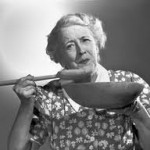
The best cooks I encounter are those who were welcomed into the kitchen as a child by a parent or grandparent. They quickly made a lasting association between cooking and love, or security, or nutrition, or family, or holiday celebrations. These children were empowered with a “can-do” attitude when it came to preparing food.
With great respect for these mentors, I have to warn you that there are some mom-myths out there about cooking that they probably should never have told you.
1) “Always boil your pasta or rice”.
Actually, “boil” isn’t a cooking method at all. You should never “boil” anything in the kitchen unless there’s been a natural disaster and you have to sanitize your water.
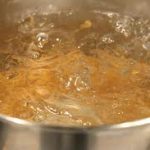 There’s a big difference between boil, simmer, and poach. These are the three moist convective cooking methods. Boil means large violent bubbles at 212f or 100c. The violent motion of the liquid often toughens protein products and can make starches sticky.
There’s a big difference between boil, simmer, and poach. These are the three moist convective cooking methods. Boil means large violent bubbles at 212f or 100c. The violent motion of the liquid often toughens protein products and can make starches sticky.
Every time you put something in the oven, it’s not at the highest temperature. Why do people think that when you cook in liquid it should be at the highest temperature possible? You must control the heat in moist cooking just like in dry cooking.
A more appropriate way to cook pasta is a proper “simmer”. Simmer is 185f (85c), characterized by small soft bubbles around the edge of the pan and slight movement to the liquid.
It’s a better way to cook pasta.
2) “Add oil to the pasta water and it won’t stick”.
Since we’re speaking of pasta, I can tell you that adding oil to simmering water will never keep pasta from sticking. That’s because the oil is running down your sink drain with the water you’ve poured out.
 Everyone knows that oil and water don’t mix. Why then, would oil cling to pasta like someone hanging from a cliff when hot water is washing it away?
Everyone knows that oil and water don’t mix. Why then, would oil cling to pasta like someone hanging from a cliff when hot water is washing it away?
If you don’t want your pasta to stick, add oil AFTER it’s cooked directly to the pasta. Or, cook to your desired doneness and rinse in cold water to stop the cooking. Then, plunge the pasta quickly in simmering liquid and strain before service. This will have washed away much of the sticky starch.
3) “Leave the frozen steak on the kitchen counter overnight to defrost”.
Some of these things your mother should have never told you are simple oversights. This one could make you very ill.
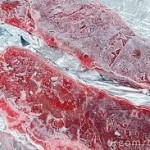 “That’s the way we always did it and nobody ever got sick”, she would retort. The truth of the matter is that our food system was much better in 1960. When I was a kid, we went to the BUTCHER for meat. The fresh cuts were wrapped in brown paper, not Styrofoam and plastic with a blood absorbing pad underneath. The meat itself was safer.
“That’s the way we always did it and nobody ever got sick”, she would retort. The truth of the matter is that our food system was much better in 1960. When I was a kid, we went to the BUTCHER for meat. The fresh cuts were wrapped in brown paper, not Styrofoam and plastic with a blood absorbing pad underneath. The meat itself was safer.
You don’t know how today’s products were handled before they reached your kitchen. Most food borne illnesses are caused by human beings, through dirty hands or cross-contamination. The second biggest cause of people getting sick from food is called “Time and Temperature Abuse”.
The “Temperature Danger Zone” (TDZ) is 41f – 135f (5c – 57c). This is the area on the thermometer at which bacteria grows most quickly. To keep food safe, it should be kept at or below the lower temperature and cooked above the higher temperature.
A steak left to defrost at room-temperature will spend too much time in the TDZ, potentially giving bacteria the opportunity to double every 20 minutes, to a point at which it causes illness. Always defrost items by planning ahead. Move frozen food from the freezer to the refrigerator 24 hours in advance to keep it out of the TDZ.
4) “Cut into the chicken and see if it’s done”.
I’ve seen too many people gash steaks and chicken breasts in an effort to visually verify that the item is cooked. The main problem with this is that you’re letting all the moisture escape. It’s like poking a hole in a hose.
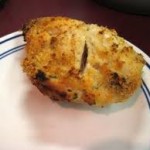 There’s an easier way to quantify your cooking, with a thermometer. It’s the single best investment you can make in your cooking. A thermometer will tell you EXACTLY when something is cooked to a desirable and safe temperature.
There’s an easier way to quantify your cooking, with a thermometer. It’s the single best investment you can make in your cooking. A thermometer will tell you EXACTLY when something is cooked to a desirable and safe temperature.
Poultry and fish are considered fully cooked and safe at 165f (74c). A quick-read digital thermometer inserted into the thickest part of the item will assure that any part thinner or smaller is at least that temperature.
Steak temperatures are for your desire, but aren’t considered fully safe until 165f (74c). To me, that’s a hockey puck. The steak is over-done at that point. I encourage everyone to use their thermometer and memory to arrive at a personal “steak number”. It’s the temperature of your perfect steak.
My steak number is 128f (53c). I let the beef rest for 5 minutes and carry-over cooking will eventually make it about 132f (55c), the perfect rare to medium I like. Generally, “rare” is 130f (54c), “medium” is 140f (60c), and “well” is 150f (65c).
5) “Cook for 20 minutes”. “Sauté for 3-5 minutes”.
Mom always seemed to be able to tell exactly when something was done cooking by the clock. But there are so many variables in cooking that no two chicken breasts will cook exactly the same, no two asparagus spears or fishes either.
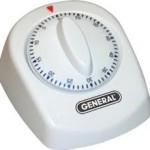 Common sense says that if one chicken breast is twice as thick as a second, the first will take longer to cook. Chickens aren’t manufactured in a factory, they are not of consistent sizes. If food is all different sizes, how can we cook by time?
Common sense says that if one chicken breast is twice as thick as a second, the first will take longer to cook. Chickens aren’t manufactured in a factory, they are not of consistent sizes. If food is all different sizes, how can we cook by time?
How hot a stove-top heating element gets is measured in British Thermal Units (BTUs). The more BTUs your burners have, the more quickly it will transfer heat. A household electric coil range with a ceramic glass top will have different size burners, generating from 5000 to 10,000 BTUs. Commercial gas ranges apply heat more quickly and intensely, with elements that produce 15,000 up to 30,000 BTUs.
If the commercial stove will give you three times as much heat, how can you cook by time?
In culinary college, my students often ask me, “Chef, how long should I cook this?” The answer is always the same, “until it’s done.” A better question is, “how do I tell when this is done?” The answer is to quantify your cooking. Learn to identify the signs of cooking on a scientific level.
When a protein product like chicken, beef, or pork reaches 165F (74c), proteins coagulate. That means they stiffen and shrink. The item changes color. At 320f (160c), sugars caramelize. They turn brown and brittle, like toast. This is always the great eye-appeal you’re looking for, or the grill-marks on a steak.
Recognizing these road-markers in cooking, along with your instant read thermometer will tell you exactly when something is done without ever looking at a clock.

Sorry Mom, I’ve grown up and so has my cooking. I love, respect and admire you for introducing me to a great world of food. However, I’ve learned the HOWs and WHYs of cooking since. I’ve asked hundreds of questions, I’ve sought more knowledge to further improve upon what I would never have started without you.
Discover how to take your cooking to the next level
in my upcoming FREE Webinar,
3 Cooking Discoveries to Change Your Food from Fair to Fantastic
Click HERE to reserve your spot for the FREE event.

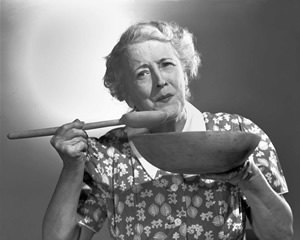

I’m glad to have your expertise at my fingertips. My mother wasn’t a cook–lots of canned foods boiled, so am continuing to love good food. You make it possible to create these foods.
Hi Caroline!
It’s a simple formula that creates care-free cooks. The CONFIDENCE in dependable, repeatable, reliable METHODS of cooking brings out the CREATIVITY to use the ingredients YOU want, and this equals endless variety and pride in accomplishment.
Hi Chef,
I learned so much from your cooking class. Thank you
The information that you give us is so wonderful, I have already started looking at my cooking in a different light. I am getting on my lady friend’s nerves, but it is a good thing because I am commenting on what I have learned. Thank you Chef.
I’m loving your classes!
Chef:I am very glad to have found you!!
Hi Jerry!
Thank you for the kind comment. I’m glad you are enjoying the freedom that comes with cooking by METHOD instead of a clock.
Thank you!
Love the lessons I am learning new things, mainly vocabulary
Great! I feel like I’ve learned quite a bit here, as I’ve done most all of those things in the kitchen, even though, my younger son, who’s a culinary grad may have shared a few of these better ways with me in the past, however, I imagine that I never fully understood them enough to see the real value in adopting them myself. Thanks, Chef Todd! You’re the Top Chef Hero, I suppose, for all us average guys in the kitchen!
Hi John!
Thank you for the kind words. Today’s cooking is much different than 50 years ago. Foods are different, they are handled differently from then. We have different cooking tools and equipment, but HOW you cook really doesn’t change. The METHODS of cooking that have been ignored in favor of written instructions are really the way to become truly FREE in your cooking.
I have been experimenting with your Method and found it fantastic to follow the order in which you can make a meal. The orange/soy Pork and apples, also made medium Porterhouse steak and the Chicken breast each one turned out as a delicious meal. Thanks Chef
Very interesting read! I don’t need even know if my mom taught me these things. I think I somehow picked a lot of them up along the way from watching others.
A quick question, do you always offer an incentive at the end of your webinars to purchase a lifetime membership at a lower discount? I’ve been trying to encourage my brother and sister to sign up.
Hi Rahel!
I don’t always make special offers at the end of my webinars. Some of them are strictly for information to empower my audience toward great cooking skills. You can refer them to my WebCookingClasses website. Have them register with their email and they’ll get notice when the next webinar is offered.
The rinsing pasta thing drives me crazy. For years “experts” said to rinse it & stop the cooking process to get that perfect al dente texture. For the last 10 years or so culinary “experts”, Iron Chefs, Restaurant Chef/Owners all say don’t rinse it – and even use a little of the starchy water IN the sauce so it sticks to the pasta. How do we know what’s right when information changes all the time? It’s like the whole “eggs are bad for you” then “they’re a perfect protein” information. So confusing.
Hi Lisa!
Let’s use some basic logic. Why would starch help a tomato sauce “stick” to pasta? You can try this experiment in your own home to discover the truth. Cook some pasta. Rinse half of it and don’t rinse the other half. Then, pour some of the simmering liquid into your sauce (and water-down your sauce). See which pasta dish you like better.
1. I read that you should never rinse your pasta, but instead you should spoon it right from the pot into the sauce, and also that starch on the pasta was good because it helps the sauce stick to the pasta. Yes, no?
2. If meat needs to be kept below 41f and cooked @ 135f what method would you use to being it from 41f up to 135f?
Hi Sandra!
1) No, all the myths about sauce sticking to unrinsed pasta are false. Adding oil to the pasta does NOT keep it from sticking together.
2) The Temperature Danger Zone is 40F/4.5C to 140F/60C. This is the zone that bacteria grows most quickly. So, your refrigerator should be 40F or below, and food should be cooked to 165F/74C and kept hot during service at 140F. As for METHOD, without sounding like Forest Gump, you could saute it, roast it, braise it, poach it, simmer it, steam it, smoke it, pan fry it, or deep fry it.
This is why I teach cooking METHODS in WebCookingClasses, so that YOU can choose the ingredients and anticipate the results based on the METHOD you employ.
Ah-Ha, is what happens when I read or view your videos. Last week I sauté filet . I was concentrating on the 75% signs of cooking and thinking of the fond when the alarm went off and summoned the fire department . They could tell I had burnt dinner. But I saved it. It was seared but inside it was perfect and for the first time my husband loved my cooking! I did did a marinade and deglazed with red wine . It was a great steak. Later in the week it did chicken breasts and a lovely veggie sauce. He liked that too. It’s a miracle using your methods. You knew my mother well….
Hi Judy!
When you have a repeatable, reliable METHOD of cooking, your results will be more consistent. As your cooking skills progress, you will be inviting people to dinner who aren’t firemen. lol.
That sounds like a great original dish. Now that you have a dependable METHOD of cooking, how will you repeat the METHOD but change the ingredients for your next original dish?
Chef Todd: I have paid for my classes but as yet I haven’t started my classe. I have some work to complete before I begin with “this work”!! What is so exciting for me to see is that many people, as above, are listening, following up and changing their badly “informed” habits. We all have them and YOU are not backing down on the lack of information that we all must have. Thanks!
Great tips. Just started your course on class 2 now. Questions I asked many times, I now have good answers to here. Thanks.
I used to rinse my pasta with cold water but my husband said it made the pasta cold. I never thought to warm them back up by dipping into simmering water quickly. Thanks for the tip, Chef Todd. ?
Here’s another idea for you Marissa –
After “shocking” your pasta by rinsing in cold water, you can saute it in garlic butter. You can re-heat your pasta in a moist method or a dry method.
I’ve always rinse my pasta after cooking and people tell me I crazy for doing it. Next time I hear that, I will share your post.
Hi Brian!
Most restaurants par-cook pasta and then plunge it into hot water before service. I find that un-rinsed pasta has too much starch and clumps together.
Even though I’ve been cooking for 40+ years, I learn something new each and every time I read something you write!! I’m really enjoying these classes. Thank you, Chef Todd.
Thank you for the kind comment, Miki. I love to see the results when people take control of their cooking back from recipes.
Chef Todd, I cooked Cheeseburgers today by sauteeing them, and I first sauteed onions, mushrooms, and California dried tomatoes in oil and butter with a little salt and pepper. Well that was cooking I put chuck ground hamburger with 1/2 cup of bread crumbs one egg and some raw onions then when the onions, mushrooms, and dried tomatoes. When they were cooked, I added them to the hamburger and mixed it all up and made patties. I put them in a hot pan with a little butter and olive oil and cooked them 75% on one side and 25% on the other side. Then I put one piece of Vermont cheddar cheese and one piece of Fontana cheese on them, and when the cheese was melted, I put the finished hamburger on toasted potato bread. I was so excited Chef! Until I bit into it. I thought Wow! This burger is going to be so full of flavor, but much to my surprise, it did not it just had a little taste. I was so sad; I thought to myself what did I do wrong, I expected fireworks Exploding! in my mouth, but I just got a little pop. Chef what did I do wrong and how can I make my food explode with flavor? My cooking has improved 100%, but the flavor is still not there. Can you show us how to make our food pop with flavor, please? Thanks Jon
Hi Jon!
That sounds like a great original burger! Ultimately, it’s the cooking METHOD that makes your food “pop with flavor”. It’s HOW you cook and the quality ingredients you use that makes the food taste great. You can play with herbs and spices as shown in WCC Lesson Week 25, but seasonings never make up for poor ingredients or improper METHODS.
I can’t tell you what will make YOUR mouth “pop”. Only you can answer that question.
I received your Web Cooking Classes for Christmas and I’m excited to get started.
Thanks for all your tips!
Hey Dawn!
Welcome! Someone must love you very much to give you an entire lifetime of cooking skills as a gift.
My mom boiled all her vegetables. The first time I has steamed broccoli, I thought it was a new vegetable. I learned early boiling killed flavor and texture. Then my son went to culinary school and introduced different ways of cooking. Now that I’m retired and have time to spend in the kitchen I’m experimenting.
Thanks for the tips, I never really thought about the oil just draining of pasta. Duh…I also appreciate the not boiling information. Good stuff.
Great post. I just read it aloud to my wife, and SHE liked it! One point of clarity however, BTU are units of capacity, not temperature. One BTU is enough energy to raise the temperature of one pound of water one degree Fahrenheit – roughly the energy in one kitchen matchhead. So, even when the temperatures are the same, a small burner will take longer to cook something than the larger burner. This is why most people put the pasta pot on a big burner, to get it boiling faster. And why a thin pan (can’t store many BTUs) on a small burner (can’t supply many) cools down when you add ingredients, leaving you with less than desirable sauteing conditions – the small capacity burner takes longer to return to a high enough temperature (>324 degrees) to saute. The results in that case are either bland, boiled ingredients or overcooked ones by the time the caramelization and Maillard flavor compounds are created at the higher temperature.
Chef Todd I like to grill my steaks but have never used a thermometer on a steak, I use the touch method which works usually well with steaks, chicken, and chops. I ordered a digital read thermometer and will try to see how close I come. I always wondered why it was back when I was a kid that everything there wasn’t really a emphasis put on cleaning surfaces while prepping the food for things like salmonella.
My mom was a good cook didn’t bake much lol, but she did well in the kitchen, I mean she baked like meatloaf and chicken, but she had an electronic skillet she made amazing pork chops, but like you said meats were bought at a butcher.
I always added oil to the water when making pasta. My Grandma always did. Thanks for the tip Chef, and i like the comment “when its done!”
I pretty much learned what NOT to do from my mother. She was terrified of salmonella and when we had pork chops, she would put them in the oven and cook them until they shriveled up into bowl-like pieces of leather. She always served pork chops with applesauce, which I would put in the pork chop “bowl”. It softened the chops enough so they could be eaten!
Hi Connie!
It’s too bad Mom didn’t have a digital instant read thermometer back then, it would have saved a lot of jaw muscles for you kids!
Simple steps to remember in the kitchen. Makes cooking fun and enjoyable Chef.
All so true Chef, except the part about chickens not being manufactured in a factory 😉
Chickens manufactured in a factory is unfortunately all too true.